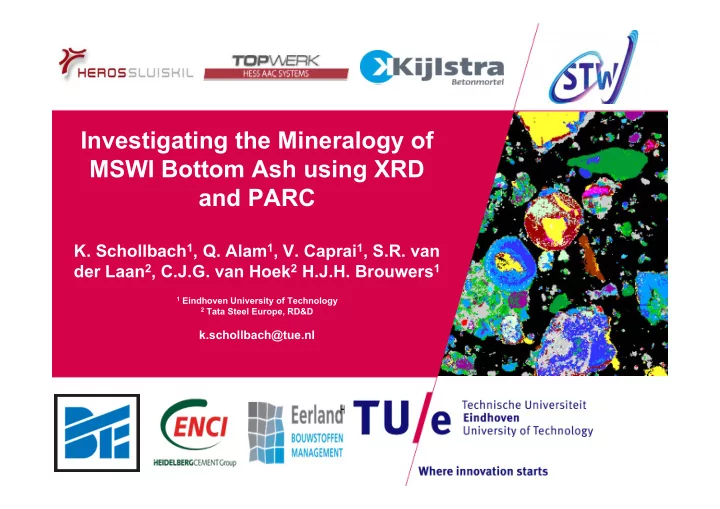

Investigating the Mineralogy of MSWI Bottom Ash using XRD and PARC K. Schollbach 1 , Q. Alam 1 , V. Caprai 1 , S.R. van der Laan 2 , C.J.G. van Hoek 2 H.J.H. Brouwers 1 1 Eindhoven University of Technology 2 Tata Steel Europe, RD&D k.schollbach@tue.nl
Municipal waste fib 2010, Lyngby
MSW Incineration/ Waste to Energy plant Fly Ash (20%) Bottom Ash (80%) ~90% Volume reduction fib 2010, Lyngby
BA Processing Plant clean 4-32mm washing filter cake 4-32 mm <0.25mm dry sieving 0-32 mm <0,25mm 0-4 mm dry sieving 0.25-1mm recycled Lab not 1-4mm recycled/too contaminated
BA Processing Plant clean 4-32mm FC washing 4-32 mm <0.25mm dry 0-32 mm sieving BA-S FBA dry <0.25mm 0-4 mm sieving 0.25-1mm Lab 1-4mm investigated
BA fines (<4mm) Problems: • by 2020 all BA has to be recycled in NL/ no landfilling • highly contaminated: Cl - , SO 4 2- , Cu, Sb… • very high porosity Positives: • very low/no metallic aluminum content • potential pozzolanic reactivity fib 2010, Lyngby
Goal of using XRD/PARC • What phases (crystalline and amorphous) are present in BA? • How much of each phase is present? • What is the composition of each phase? • Are contaminants located in specific phases? • Can modeling of leaching/treatments be improved based on this information? • Can the pozzolanic reactivity be predicted based on this?
Leaching behaviour FBA BA-S FC Element SQD Limits (<4mm) (<0.25mm) (<0.25mm) Sb 0.32 0.22 0.82 2.4 - mg/kg ds As 0.9 < 0.0 0.06 < 0.3 Ba 22 0.7 0.82 0.4 Cd 0.04 < 0.001 - < 0.02 - One batch Cr 0.63 0.12 1.79 0.2 shaking test: Co 0.54 < 0.03 0.036 < 0.02 Cu 0.9 14 9.64 1.3 Pb 2.3 < 0.1 0.12 0.1 72h, L/S=12 Mo 1 1.1 2.02 0.7 Ni 0.44 0.24 0.077 0.07 Se 0.15 < 0.007 - < 0.2 Sn 0.4 < 0.02 - < 0.1 V 1.8 < 0.1 - < 0.1 Zn 4.5 0.48 - 0.4 Cl - 616 6200 11013 2966 SO 4 1730 1700 2558 21179 2-
Mineral Phases FBA BA-S FC Mineral Formula 0-4mm <0.25 <0.25 % wt. % wt. % wt. Melilite 4.7 0.7 (Ca,Na) 2 (Al,Mg,Fe)(Al,Si) 2 O 7 3 Feldspar 5.7 1.4 CaAl 2 Si 2 O 8 3.9 Calcite CaCO 3 13.5 25.6 17.4 Ettringite Ca 6 Al 2 (SO 4 ) 3 (OH) 12 ·26H 2 O 0.2 4.1 10.4 Gypsum 0.2 2.6 CaSO 4 ·2H 2 O 5.4 Halite NaCl 0.8 0.7 0.4 Apatite 6.5 - Ca 5 (OH)(PO 4 ) 3 5.2 Quartz SiO 2 12.5 2.1 7 Hematite Fe 2 O 3 3.8 2.2 1.2 Magnetite/Spinel Fe 3 O 4 8.9 0.5 3.8 - Other 7.1 0.4 4.2 - Amorphous 36.1 34.9 63
SEM – Single point EDX
SEM – Elemental mapping Al Mg Si
PARC - Phase Recognition and Characterization • Software compares spectral image from each pixel and groups them into phases according to composition • no information about crystallinity
FBA (0-4mm)
BA-S (>0.25mm) 128 μ m
FC (<0.25mm)
Outlook - Contaminants • Result: amorphous and crystalline phases present composition and amount of each phase • determination of trace element/contaminant content with PARC difficult Microprobe
Outlook - Reactivity FC after digestion in NaOH larger area analyzed 8x8 fields 512 μ m
Thank you for your attention PAGE 18
Recommend
More recommend